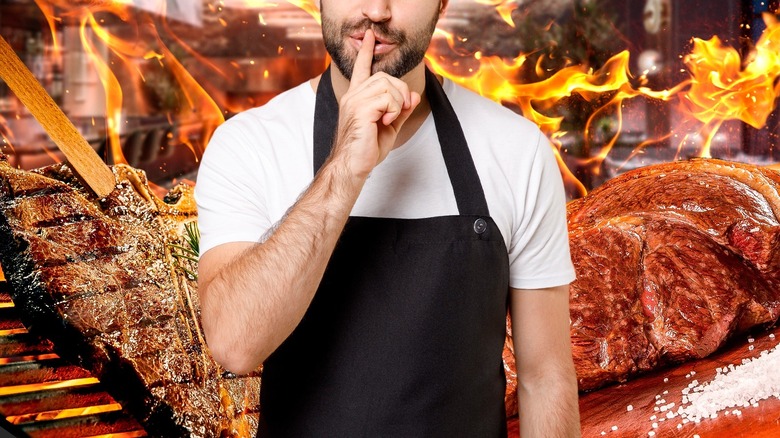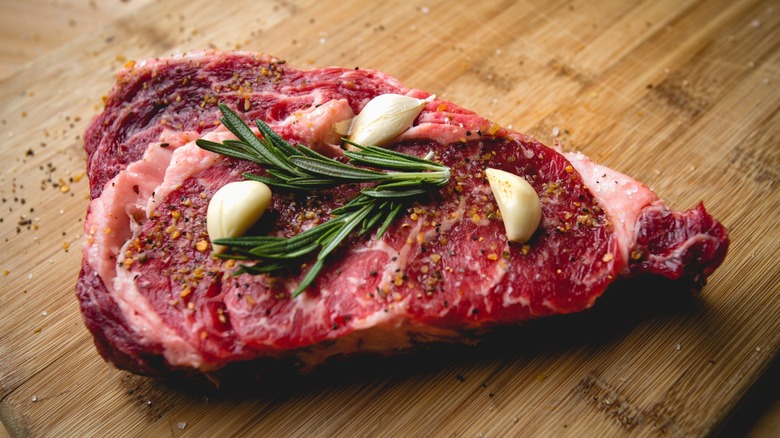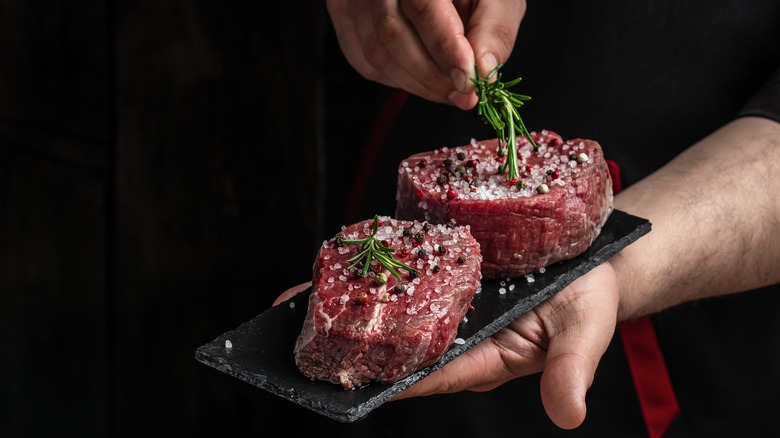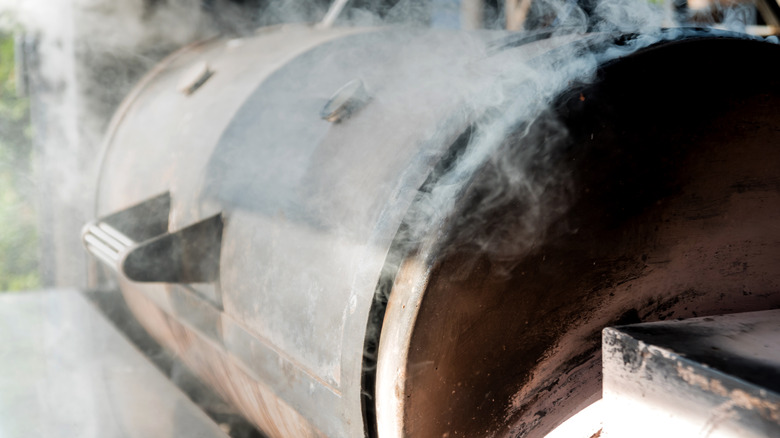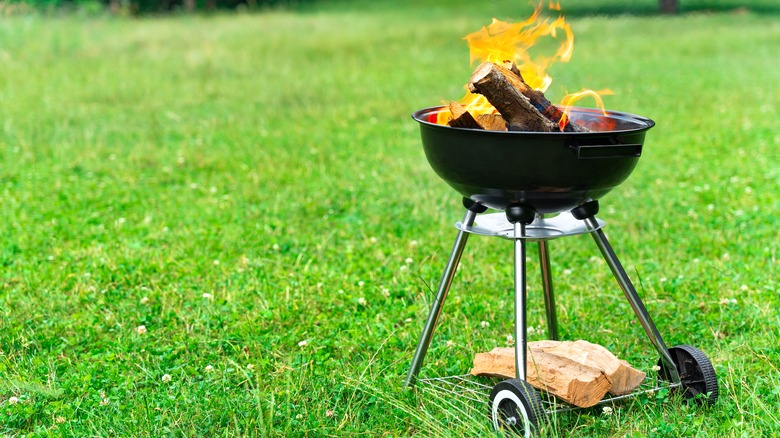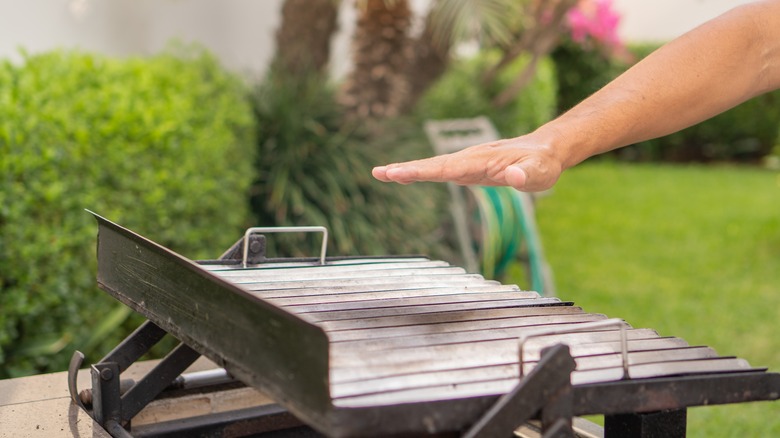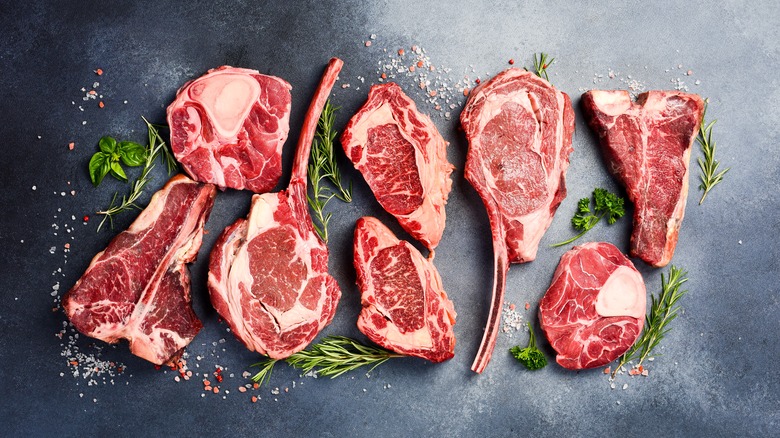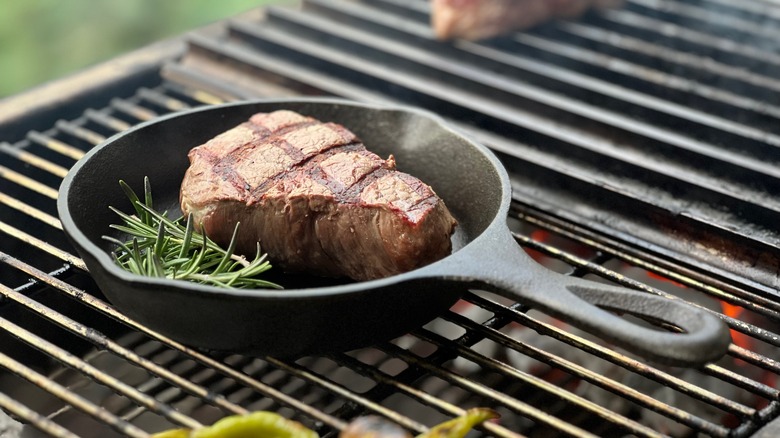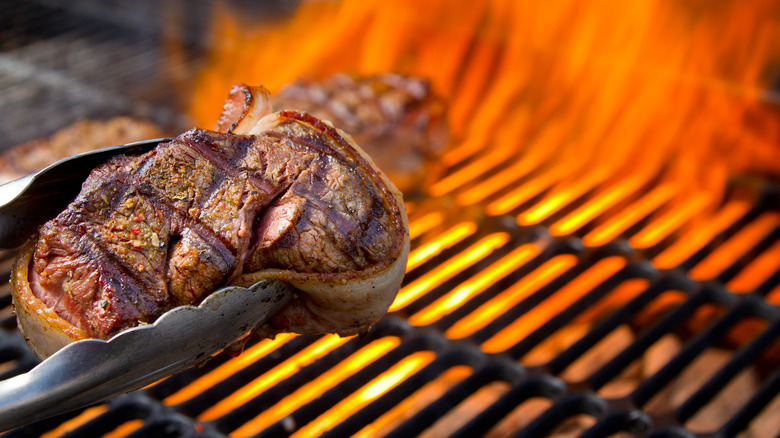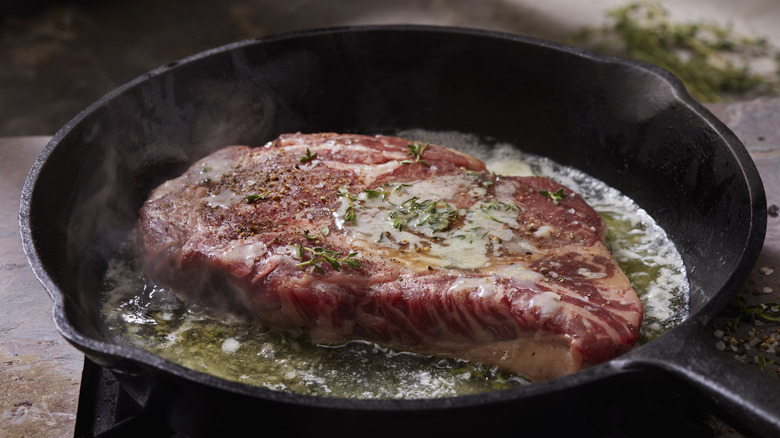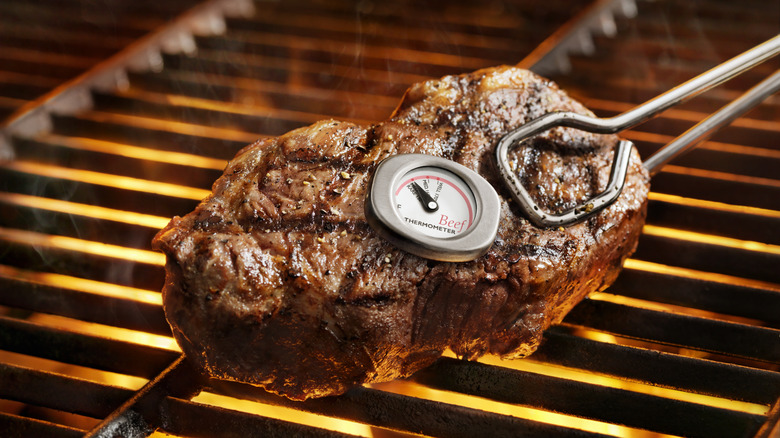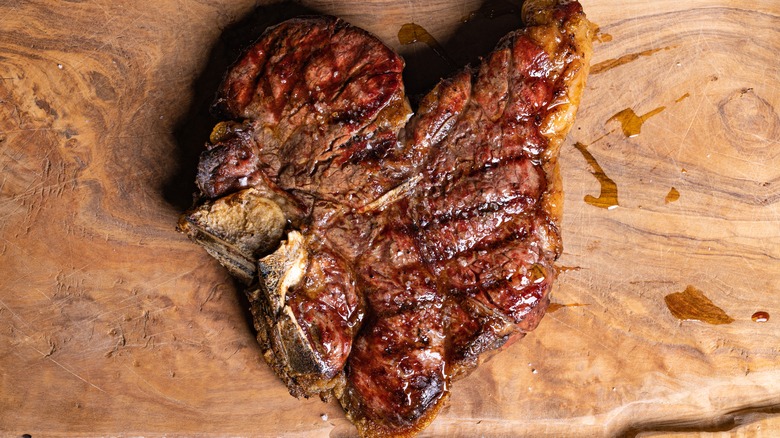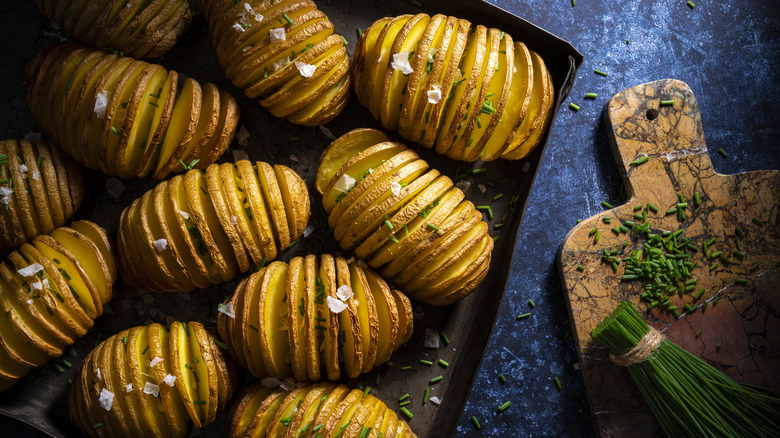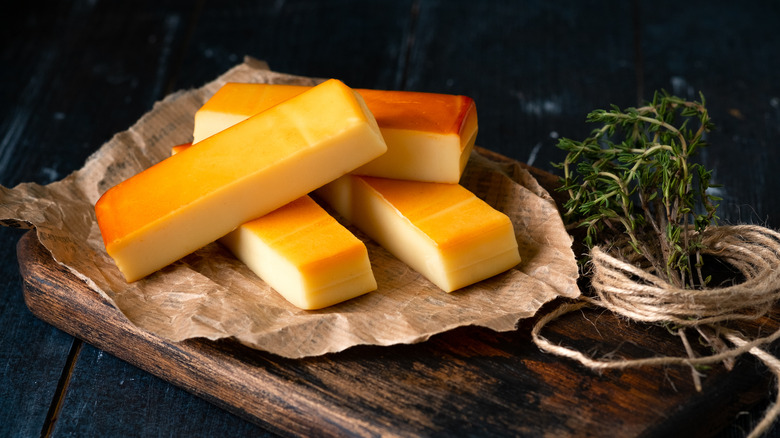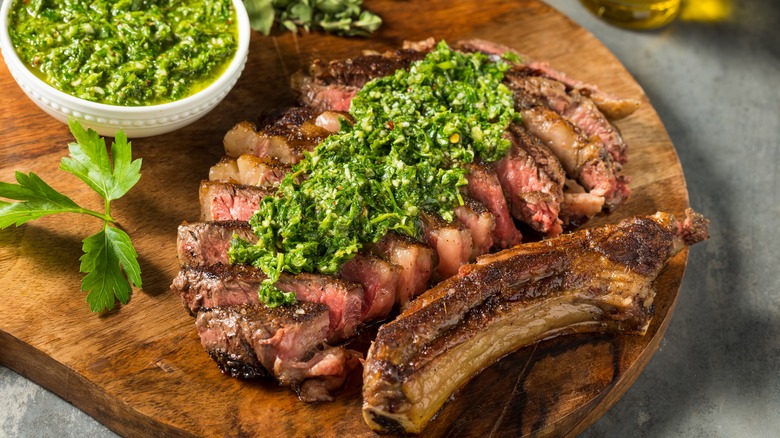14 Steakhouse Secrets That Will Make Your Food Taste Better
Have you ever wondered why restaurant steaks always taste better than the ones you cook at home? It's not just because the professionals can access better meat products and kitchen equipment. Savvy chefs also have numerous tricks up their sleeves and use special techniques to achieve juicy, flavorful steaks and top-notch sauces and sides. The good news is you can also use those cooking techniques to create steakhouse-worthy meals at home.
To help you up your steak dinner game, we spoke to numerous experts — chefs, sauce experts, and leaders in the grilling industry — about how steakhouses transform standard beef and sides into sublime meals. And they were more than happy to reveal their secrets and share their tips on everything from getting the perfect sear to best practices for seasoning and how to upgrade side dishes. The next time you're planning on throwing a few steaks on the grill, consider trying a few of these methods for a meal that wouldn't be out of place in a high-end steakhouse.
Choose steaks with a high fat content and don't be afraid to try underrated cuts
A great steak starts with ... well, a great steak. As Kylian Goussot, executive chef of Lafayette Steakhouse, told us, "It's difficult to make a good steak bad, but even harder to make a bad steak taste good." Goussot recommends choosing a cut with some fat, such as a ribeye or a cowboy steak. He said, "The fat melts during cooking and penetrates the meat, keeping it moist." Other fatty cuts include the New York strip, a T-bone, and skirt steak. And for beautiful marbling, you can't go wrong with Wagyu.
Many of the experts we spoke to also recommended trying different cuts to take your meal to the next level. For example, you could swap your filet mignon for a flavorful chuck flap or hanger steak. Carlos Anthony, executive chef at Hawkeye & Huckleberry Lounge, said, "I love the coulotte. This is the cap of the top sirloin, great for grilling whole-lean meat with an amazing fat cap. This cut is flavorful and delicious. Just don't tell anyone about this butcher's secret cut!"
Steak can handle a lot of salt -- don't be afraid to use it liberally
One of the biggest mistakes that people make with steak is not seasoning it properly. Salting your steak is crucial for several reasons. First, the salt draws moisture to the surface of the meat. Some moisture evaporates, but much of it is reabsorbed into the meat, which seasons the interior. Salt also tenderizes the steak by breaking down some of the muscle proteins. This results in a juicer steak. If you want to season like a pro, be generous with your salting. Chef Carlos Anthony recommends using about 2% of the weight of the steak in salt.
In addition to salting liberally, you also want to time your salting right to get a satisfying crust. Most chefs agree that longer is better. "I salt my steaks about an hour before cooking, letting them sit out to sweat," David Figueroa, president and co-founder of Melinda's Foods, said. "After they release some moisture, I pat them dry with a paper towel, salt them again, and add fresh ground black pepper just before they hit the pan or grill."
Lightly smoke your steak before cooking it
Nothing beats the smoky flavor of a steak fresh off the grill. But what if there was a way to enhance that smoky taste and aroma? Chef Robert Liberato, corporate concept chef of STK Steakhouse, let us in on a little-known trick. He said, "One great steakhouse secret is to lightly smoke your steak before cooking it. This technique adds a rich depth of flavor and transforms the entire dining experience. After smoking, cook the steak as usual for a truly amazing, steakhouse-worthy meal."
Leroy Hite, founder and president of Cutting Edge Firewood, is also a big proponent of smoking steak before grilling it and offered some tips for getting the best smoke on your steak. "Smoke your steak at a low temperature — 215 to 250 degrees; I like 215 degrees — and get the steak temperature to about 15 degrees under how you like them cooked," he said. "Then sear the steak — get the fire as big as you safely can and sear the steak one minute on each side directly above the fire." Don't have a smoker? Not a problem. Check out this hack for turning any grill into a smoker.
Consider wood as a fuel source
Whether you're planning on pre-smoking your meat or simply grilling your seasoned steak as is, many chefs believe that wood is the key to creating amazing flavor. That's because the smoke from the wood can infuse the steak with unique flavors and aromas that you just won't get from charcoal or gas. Plus, wood is all-natural, easy to light, and it creates a ton of heat. Wood also burns for longer than charcoal, so you don't need to replenish it as often.
According to Leroy Hite, the type of wood you choose can make or break a steak. For the best results, he recommends using high-quality kiln-dried cooking wood. In addition, different woods will impart different flavors to the meat. For example, wood from fruit trees will give the meat subtle hints of sweetness, while oak will give it a more robust smoky flavor. Hickory can offer hints of bacon and pecan can give a nutty flavor. Hite prefers using hickory, cherry, and pecan wood for grilling.
Use the pull-away hand test to check the temperature of your grill
When it comes to grilling like a master, temperature control is of the utmost importance. If your grill isn't hot enough, your steak could stick to the grates and you won't get that beautiful sear that's so important for sealing the juices in and giving your meat that caramelization and smoky flavor. On the other hand, if your grill is too hot, your steak may get burnt on the outside and undercooked inside. Finding the balance is so important for creating steakhouse-level meat.
"To test if your coals are hot enough for cooking, you can hold your hand about six inches above the coals and count how long it takes before you want to pull away," Jonathan Gill, executive chef of RingSide Steakhouse, said. According to Gill, if you can only handle the heat for only two to four seconds, that means your grill is at high heat. Five to seven seconds indicates medium heat and eight to 10 seconds is low heat. Anything longer is too low. If you can handle the heat for up to a minute, Gill said you may as well "use the camp stove instead."
Your steaks should be at room temperature before cooking them
So you've pulled your steaks out of the fridge, seasoned them liberally, and fired up your grill or skillet to a screamingly hot level. You throw the steaks on and to your dismay, they end up scorched on the outside and far too rare in the middle. Where did you go wrong? It could be that your steaks were just too cold. Regardless of how hot your grill is, cold meat won't cook as evenly as meat that's at room temperature.
Lior Lev Sercarz, chef and owner of La Boîte, said, "The cold meat will cause the grill to cool down immediately (and cook less effectively). This can also lead to uneven cooking because the outside may be charred while the inside is undercooked. Ideally, you want to start with meat that is closer to room temperature for a nice even cook throughout." A pro tip to cook beef evenly every time is to take your meat out of the fridge and let it sit for 30 minutes to an hour to ensure it comes to room temperature.
Use a hot cast-iron skillet or carbon steel pan over a grill for the best sear and crust
There are several ways to cook a steak, from grilling to broiling and even the sous vide technique. However, many chefs agree that a cast iron pan is important for a good seared steak. "I prefer using a hot cast iron skillet or carbon steel pan over a grill for the best sear and crust," David Figueroa said. "Steakhouses use broilers or flat surfaces to achieve this, and a hot pan can replicate that perfect crust."
Chef Michael Mina, founder of MINA Group and Bourbon Steak, elaborated further. "A cast iron griddle excels in heat retention and distribution, ensuring consistent cooking results," he said. "When cooking steak in particular, you want to ensure you're getting an even sear across the surface of the meat, while also imparting that crust-like texture and rich flavor that's synonymous with a restaurant-quality steak." Chef Mina also cited the fact that cast iron has a naturally non-stick surface, which makes it easy to flip the meat. In addition, natural seasoning builds each time you cook with it, adding even more flavor to your food.
Start hot, then lower the temperature
One of the golden rules many of us are taught about cooking steak is that you need to sear it at a high temperature first to create a crust and seal the juices in. Chef Kylian Goussot explained, "Cooking your meat on a properly heated surface will maximize the Maillard reaction. This reaction is simply the result of cooking the meat at a high enough temperature on the surface for it to start caramelizing. This is what gives that addictive flavor everyone loves."
Pro grillers know that it's crucial to preheat the grill or pan ahead of time and wait until it's blazing hot to add the meat. Be patient, because as Chef Nickenford Joseph of Vinyl Steakhouse warned, "Not getting the pan hot enough will not create a nice sear/char on the steak, resulting in a lack of flavors. I would say get the grill between 450 to 500 degrees. Get a nice sear on both sides of the steak to create a tasty crust and lock in the flavor." Many chefs also recommend flipping the steak often to allow the meat to cook more evenly.
You can also try the reverse sear
There's no denying that searing your steak first can give you a delicious caramelized crust. However, one of the biggest myths about searing steak is that the initial kiss of sizzling heat is the only way to go. Another technique can help cook the meat more evenly, while still giving you that gorgeous browned crust. It's called reverse searing and it involves cooking your steak gently first, then hitting it with high heat to give it a great sear.
For reverse searing, Chef Jonathan Milan of Ocean Prime in Beverly Hills recommends the sous vide technique. "Let's face it, there's no reasonable grill or broiler you can use at home that will give you those 1,600 to 2,000-degree temperatures that steakhouse broilers have," he said. "Sous vide your steak to the desired temperature. Dry it out, let it come to room temperature, and sear it in a ridiculously hot pan or grill. Once a great sear is achieved, just serve it with your favorite sauce."
Use a meat probe to monitor and manage temperature
If there's one thing that can ruin even the best cut of steak, it's cooking the meat too long. As Carnivore Style chef and owner Adonis Icalina said, "Overcooking leads to a tough, dry steak that lacks flavor." One surefire way to avoid overcooking is to use a meat probe, aka a meat thermometer, to check how hot it is inside. "For a medium-rare steak, you want it to hit 130 to 135 degrees Fahrenheit," Icalina said. "Keep in mind that the steak will keep cooking a bit after you take it off the heat, so it's better to cook it a bit underdone."
Not a fan of medium-rare steak? There are also some general guidelines for the ideal temperatures of rare, medium, and well-done steaks. If you like your steak rare, cook it to 115 degrees Fahrenheit at its thickest point. It should come up to about 120 degrees by the time it's ready to eat. Medium steaks should reach about 140 degrees, while medium-well should be about 150 degrees. Well-done steaks should be cooked to about 155 degrees on the grill and served between 160 to 165 degrees.
Resting the meat is crucial
After all your hard work seasoning, searing, and cooking your steak to perfection, it can be tempting to dive right into your masterpiece. However, nearly every expert we spoke to said that it's a major mistake to cut into meat right off the grill. Adonis Icalina said, "When you cook a steak, the juices inside get very hot and move towards the center. If you cut into the steak immediately after cooking, those juices will spill out onto the plate, leaving the meat dry."
The key to juicier, more flavorful meat is allowing your meat to rest after you take it off the grill. Resting allows the juices in the steak to redistribute throughout the meat. It also allows some of the muscle fibers to expand slightly, which results in more tender meat. Most chefs agree that you should let your meat rest for at least five to 10 minutes and even up to 45 minutes depending on how thick the meat is. As Lior Lev Sercarz said, "The longer it takes to cook, the longer it should be allowed to rest so the juices can settle in and not be lost to the first cuts."
Don't settle for boring potatoes
Steak and potatoes are a classic combination, but they can also be a little bland. Steakhouse chefs know that the key to an amazing steak dinner is to really make the flavors pop in the side dishes. "Eating rich fatty meat with rich fatty sides is a pallet blowout and will need freshness and acidity," Jonathan Milan said. "Pack your starches with a lot of cream and butter, and have some charred broccoli tossed with lemon or a fresh salad on the side. At home, nothing goes better with my steak than a well-aged piece of kimchi."
ButcherBox chef Ashley Lonsdale also recommends amping up the fat and acid content in the sides. "If you are hoping to emulate the steakhouse side flavor, be prepared to use a little more butter, cream, and cheese than you may be used to," she said. "I always include something acidic like a bright salad or marinated grilled vegetables to balance the richness of the steak. Also, don't be afraid to grill your sides if you're already heating a grill to cook your steaks. It's a great way to carry the charred and smoky flavor throughout the meal."
Use smoked cheese in your sides
If you're looking for a unique ingredient to use in your side dishes, Leroy Hite recommends smoked cheese. Although many wouldn't associate smoked cheese with steak, Hite says it makes for an excellent addition to steakhouse sides. "Smoked cheese is incredible and it is so versatile," he said. "Put an aged Tillamook cheddar in a metal bowl or dish and smoke over cherry wood at 250 degrees for 30 minutes. Once it's smoked, you can use the delicious smoky cheese in casseroles, salads, flatbreads, and on a charcuterie plate."
There is one classic steakhouse side that can benefit from smoked cheese. Add some smoked gouda or a cheese you smoke yourself to your mac and cheese and you have an instant upgrade to the dish. Another way you can achieve that rich smoky flavor is to add liquid smoke to your mac and cheese. Alternatively, you can cook your mac and cheese in a backyard smoker or on the grill to enhance the smoky flavors.
Vibrant sauces can make the meat shine
Many chefs will tell you that a great cut of steak doesn't need anything more than salt and pepper. That may be true, but a great sauce can take your steak dinner to the next level. The trick is to choose a bold sauce that can stand up to the flavors of the meat. Some ultra-flavorful sauces that go well with steak include peppercorn sauce, chimichurri, red wine sauce, blue cheese sauce, and béarnaise.
When it comes to sauces, Jonathan Milan said, "Not everybody has the means or the time to make expensive butter sauces or wine reductions. And to be honest, you don't need that to have a killer steak experience. Look at what other cultures eat with their steak. Think of chimichurri with fresh herbs or a fiery harissa with mint raita. Nuoc cham is an amazing condiment as well or mixing a quality sesame oil with chunky sea salt is incredible with a great steak. Have fun and get outside of your comfort zone."
